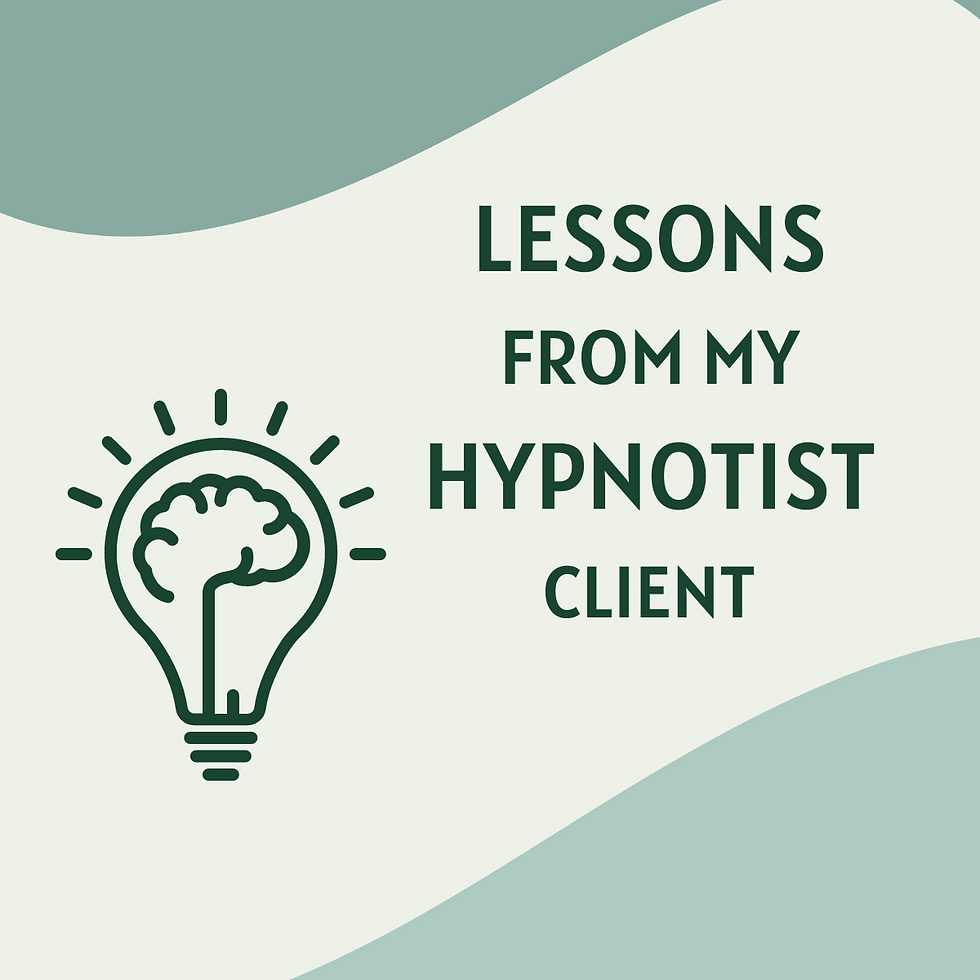Lessons from my Hypnotist Client: Making Creative Space in a Crowded Mind
- Abigail Caress

- Feb 7, 2024
- 4 min read
It was a normal website management consult for a small business client named Wally: we met at his home office, a quiet and cozy backyard modular building at the end of a curving walking path from an extended driveway parking zone. We discussed his frustration with his current (and costly) corporate-based website manager contract. We looked into the backend website platform to assess how deeply I could dig in to make changes if management passed to me. It turned out fine.
But one element of my meeting felt unusual: Wally is a hypnotist and, although not a mind-reader per se, he’s equipped to observe and pick up on the thinking patterns and capacities of others.

So after we’d addressed a few of his concerns about the website, he turned to me and said, “You speak quickly, with a rapid flow. That means you can see your ideas—almost like a movie, a moving picture in your mind of those ideas, and you verbalize them as you go.”
I blinked. “Yes, it’s exactly like that.”
“I know some of this work—” he gestured at his computer and mine, “might require you to be able to edit written pieces about hypnotism. Do you know much about it? Have you ever been hypnotized before?”
I told him how my dad, a former psychologist whose professional focus took him into the school psychology sphere, had once tried a session with me when I was a child after he had a workshop experience. It hadn’t worked.
“Hmm. The field has changed quite a bit in terms of techniques since the 1990s. And you were likely in a different dynamic – working with your dad, who is Dad, and in your mind, not a hypnotist. Your expectations here are different, since you would expect a professional to be effective at hypnotism. Would you like to try a session now? Your kind of mind is actually ideal for hypnosis.”
So I consented, my natural curiosity open to the experience.
He asked a few initial questions about some goals I might have in hypnosis. I described to him some of the mental struggles I juggle daily: mostly a heavy mental load of responsibility as our household’s default parent and as a remote worker who strives for efficiency in my child-free hours. And how at night, when I need to dig into my other passion projects as an author, I struggle to push my brain into an open, relaxed and creative mental mindscape instead of lapsing back into the grinding, task-oriented machine-like mental setting that dominates my daytime work and enables me to keep track of my many duties.
“But can you access it sometimes, that creative mental state?” he asked.
“Yes, mostly in those liminal spaces during mindless tasks where my brain can zone out, like in the shower, folding laundry, reading a really good book, things like that. I come away with ideas and scramble to write them down.”
“That ‘zone out’ is exactly what a hypnotic state is.”
“It is?”
“Yes. Most people experience it as a quietly active, focused state. Like when you’re out driving and go into autopilot thinking about something else, and yet you manage the drive, but can’t remember the whole journey. Or when you are reading and you’re essentially hallucinating the experience that you read, very deep in the story, as the pages fly by. That space you enter is hypnotic. The brain is working, working very hard, in fact, just at a deeper, quieter, more imaginative level. And while you are thinking, the filters come off your mind, and other feelings and thoughts can emerge.”
Huh.
So I settled into the comfy recliner with a weighted blanket on my lap and let him guide me to that space. In minutes, following his voice downward and inward, I was there.
Quiet. Calm. Open possibilities. Vivid imagining.
I knew this space.
It was my writing space.
My recovery space.
My deep focus space.
It was my quiet prayer space, too.
And it had been so hard, so hard, in my busy, busy life, to access this kind of mental space.
And it had been so hard, so hard, in my busy, busy life, to access this kind of mental space.
I was often too anxious to allow myself to get to this sort of state (relaxed!) because there would be things I would be neglecting or forgetting to accomplish. I loved that space but feared the loss of awareness I thought might come with it.
But strangely, I found that in hypnosis, I was still aware, just not frazzled by what was there in my awareness. I was holding my knowledge, but free of its weight. And some of that burden, Wally had me visualize and push farther away.
“I can teach you how to do this,” he said, after I’d surfaced and was feeling refreshed. “Self-hypnosis can be learned, and I think you can learn it.”
Me? Learn how to access this quiet, creative, imaginative mindscape on demand? Yes.
So now I’m on a self-hypnosis student journey, trying to learn and practice this skillset to help me manage my mindsets for creative and workspaces. As a bonus, the hypnotic state is also emotionally refreshing because it’s a safe place – a space where old hurts somehow hurt less, and can be dealt with, granting emotional freedom, too.
To join in on a similar journey with Wally, check out his website (with more updates to come from me!) at andersonhypnosiscenter.com.




Comments